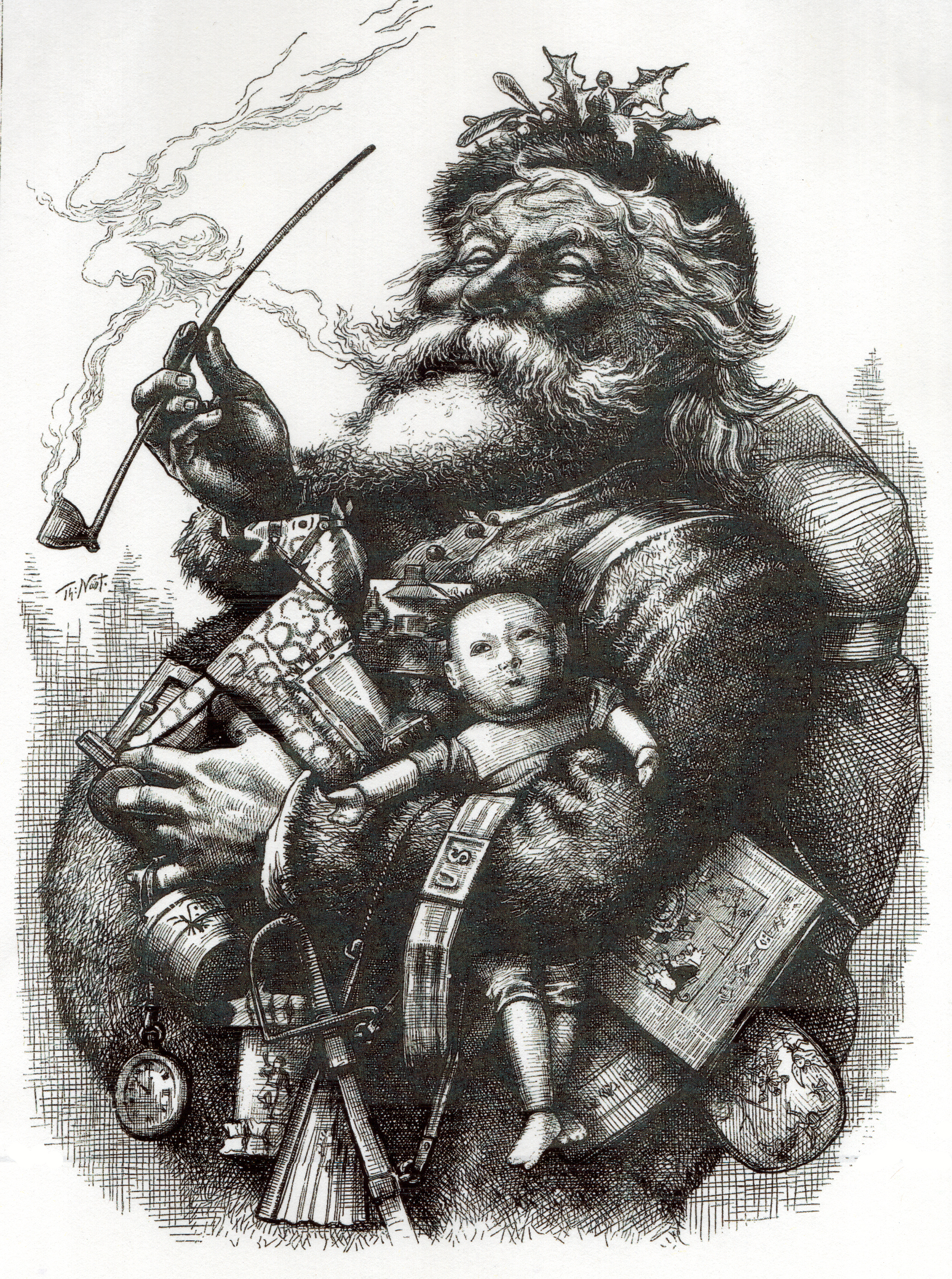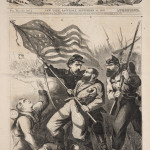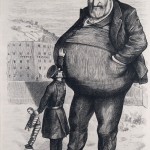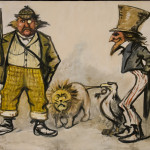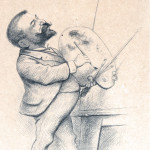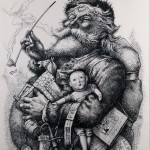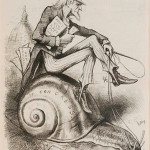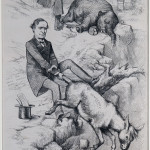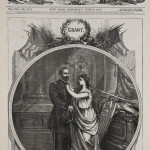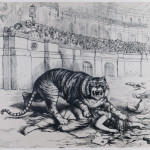The works by Thomas Nast in MHHM's collection, many directly from the artist's family, include pencil and ink drawings, sketches, watercolor and oil paintings, preliminary drawings and doodles, and artist and printer proofs. MHHM also holds a Nast Archives containing a selection of the artist's personal correspondence and photographs, including a family photo album. While Nast's work is always on display, specific works in the collection are available for research by appointment.
Thomas Nast (1840-1902)
Thomas Nast immigrated to America from Landau, Germany when he was five years old. With limited education and little artistic training he joined the art staff of Frank Leslie's Illustrated as a teenager. In 1860 Nast traveled to Italy as a war correspondent for The Illustrated London News and New York Illustrated News. Embedding himself with Giuseppe Garibaldi's campaign to liberate and unify Sicily and the southern Italian states, Nast depicted what he saw in pencil, crayon, ink, and paint in a sketchbook now in MHHM's collection.
Upon his return to the United States in February 1861, Nast began to cover the American Civil War that April for New York Illustrated News. In 1862, the artist joined Harper's Weekly as its war correspondent. Just 22 years old at the time, Nast created illustrations based on reports of what was happening on the battlefield. He worked for the weekly until 1877, and again from 1895-1896. During his tenure, Nast created hundreds of cartoons including the Democratic Donkey, Republican Elephant, Uncle Sam, Columbia, Tammany Tiger and Santa Claus. Nast also created cartoons commenting on issues of the day using derogatory ethnic and racial stereotypes. Nast illustrated stereotypes of Black Americans, as well as Irish and Chinese immigrants. The artist also published Anti-Catholic cartoons attacking the Church hierarchy. At times, Nast drew derogatory caricatures in support of a person or group. In other instances, Nast used stereotypes to make a visual case against a person or group.
In 1871 Nast moved his family out of New York City to Morristown, NJ, believing it to be a safe distance from his political enemy, William "Boss" Tweed of New York. Although Nast's work for Harper's Weekly took him to New York regularly for overnight stays, Nast was an active resident of Morristown. He was an honorary member of the fire department and supported the efforts of the local lyceum and other charities. Many of Nast's drawings depict his family home since 1872, Villa Fontana, located just across the street from Macculloch Hall.
Following reversals in both his relationship with the editor of Harper's Weekly and in his personal fortune, Nast was nearly bankrupt by the turn of the nineteenth century. In 1902 President Theodore Roosevelt appointed Nast a minor diplomat to Ecuador. It was the only steady paying job the artist could find. Nast traveled to Ecuador where he died of yellow fever just a few months after his arrival.
Additional Resources:
The Political Cartoonist Who Helped Lead to 'Boss' Tweed's Downfall | History.com
- A Gallant Color-Bearer
- Can the Law Reach Him? – The Dwarf and the Giant Thief
- Sorrowful John and Joyful Jonathan Thomas Nast (1840-1902) 1888 Oil on canvas TN85.01
- Self-Portrait for Christmas Card
- Merry Old Santa Claus Thomas Nast (1840-1902) Harper’s Weekly January 1, 1881 Engraving TN2015.182
- The Lightning Speed of Honesty Thomas Nast (1840-1902) Harper’s Weekly November 24, 1877 Engraving TN2015.179
- Stranger Things Have Happened
- Grant Thomas Nast (1840-1902) Harper’s Weekly June 6, 1868 Engraving TN2004.84A-C
- The Tammany Tiger Loose- What are You Going to Do About it? Thomas Nast (1840-1902) Harper’s Weekly November 1871 Printer’s proof TN2004.60
Select Works
Thomas Nast / Engraving / Harper’s Weekly / December 7, 1878
This humorous Thomas Nast cartoon needs little explanation. The brave boy on his rocking horse hunts for turkeys before Thanksgiving Day and below the revenge of the turkeys on the boy after dinner, who is not as brave anymore as he clings to the horse’s neck.

Thomas Nast / Engraving / Harper’s Weekly / November 20, 1869
In this image, Uncle Sam and Columbia play host to a full dinner table of 28 men, women and children representing some of the ethnic populations in the United States. Nast illustrates the figure of Uncle Sam carving the turkey dinner. The figure of Columbia, representing America, is opposite him in the foreground.
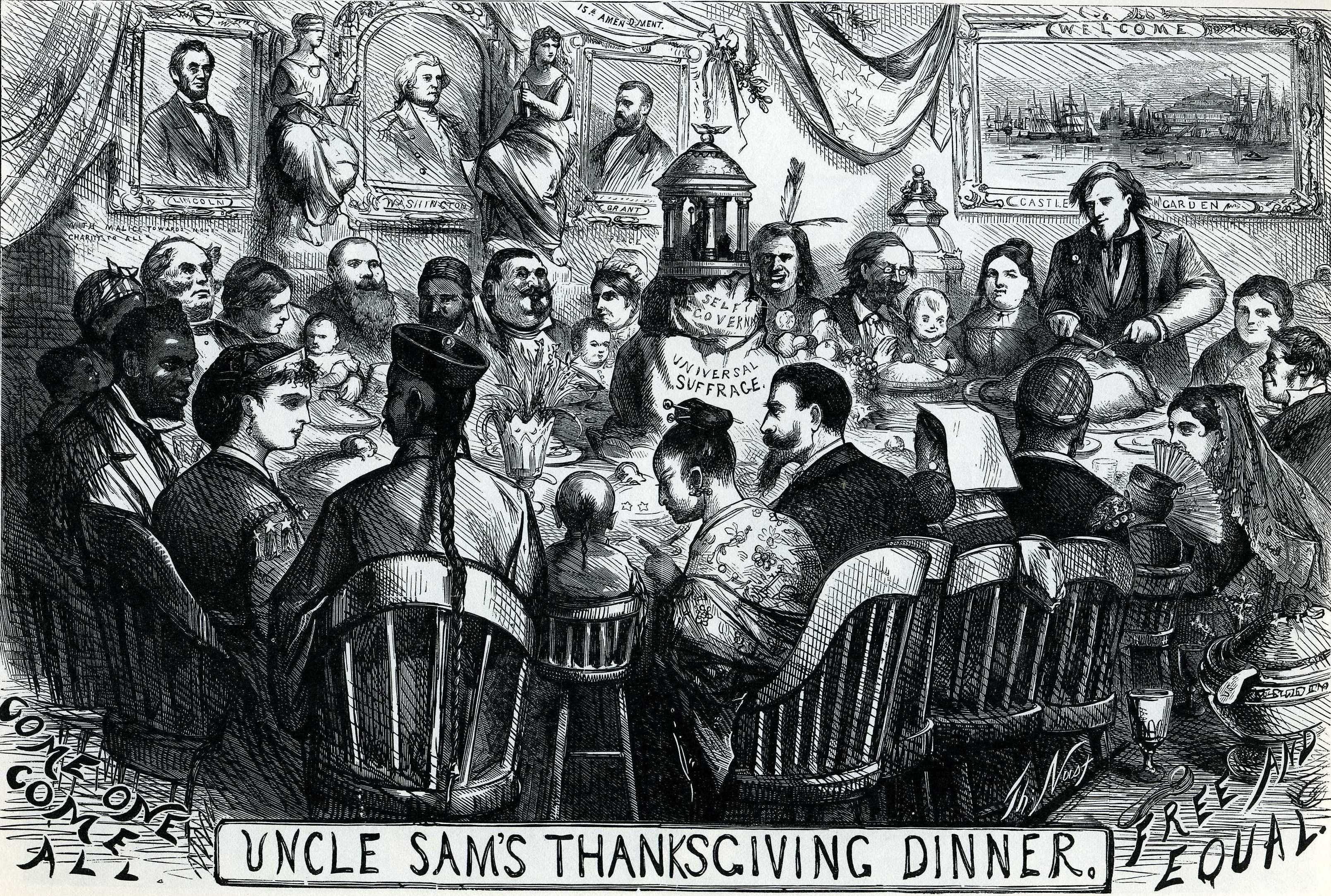
Thomas Nast / Engraving / Harper’s Weekly / December 3, 1864
President Lincoln dominates the center of this Civil War Thanksgiving Day drawing by Thomas Nast. Soldiers and Sailors are shown across the bottom vignettes. Thomas Nast supported the Army and Navy through his entire career.
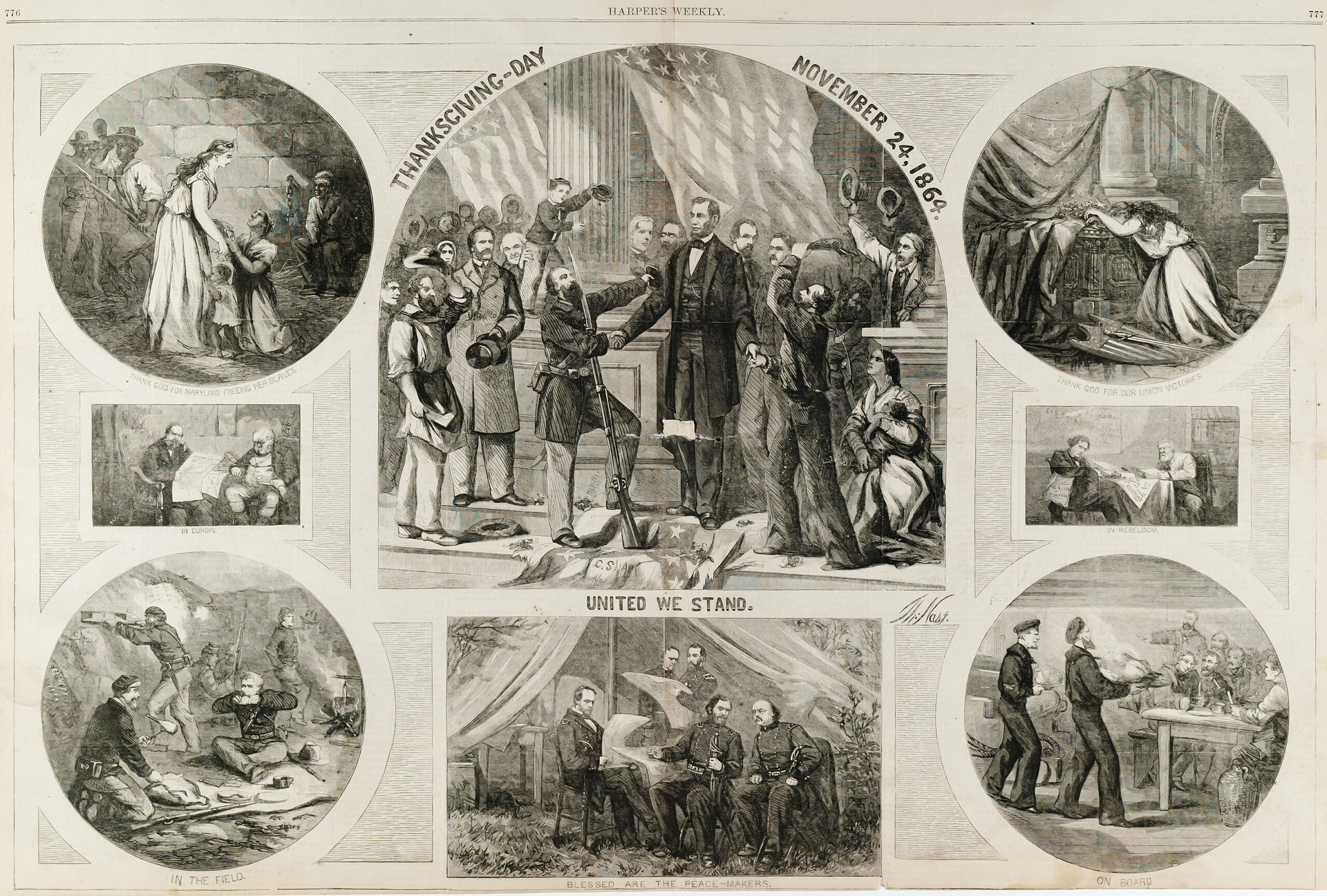
Thomas Nast / Engraving / Harper’s Weekly / December 5, 1863
Thomas Nast created this Thanksgiving double folio during the Civil War in 1863. Columbia is featured in the center praying at the Union Altar. She looks up to the top center panel of 2 of Nast’s favorite Presidents, past and present, Washington and Lincoln.
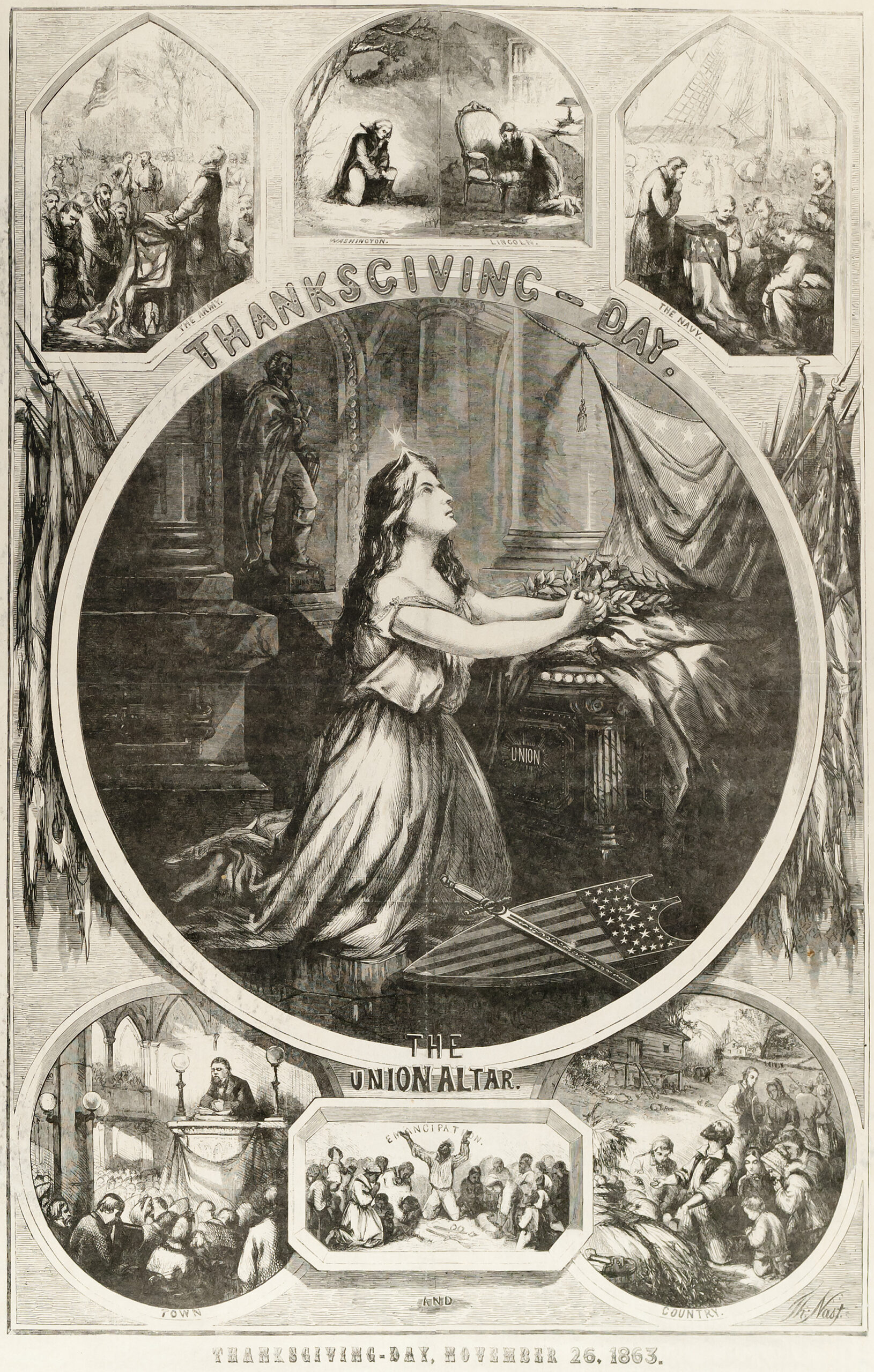
Thomas Nast / Engraving / Harper’s Weekly / November 12, 1864
In this double folio image, Columbia stands proud in the large top vignette casting her vote for the Union and Abraham Lincoln. The bottom three scenes show the soldiers still fighting in the war casting their votes for President Lincoln; in the central scene the Veterans vote for “no compromise, down with slavery” and “down with the rebels.” The final scene shows citizens voting. This cartoon, though dated November 12, 1864 actually ran on November 2— almost a full week before the November 8 election.
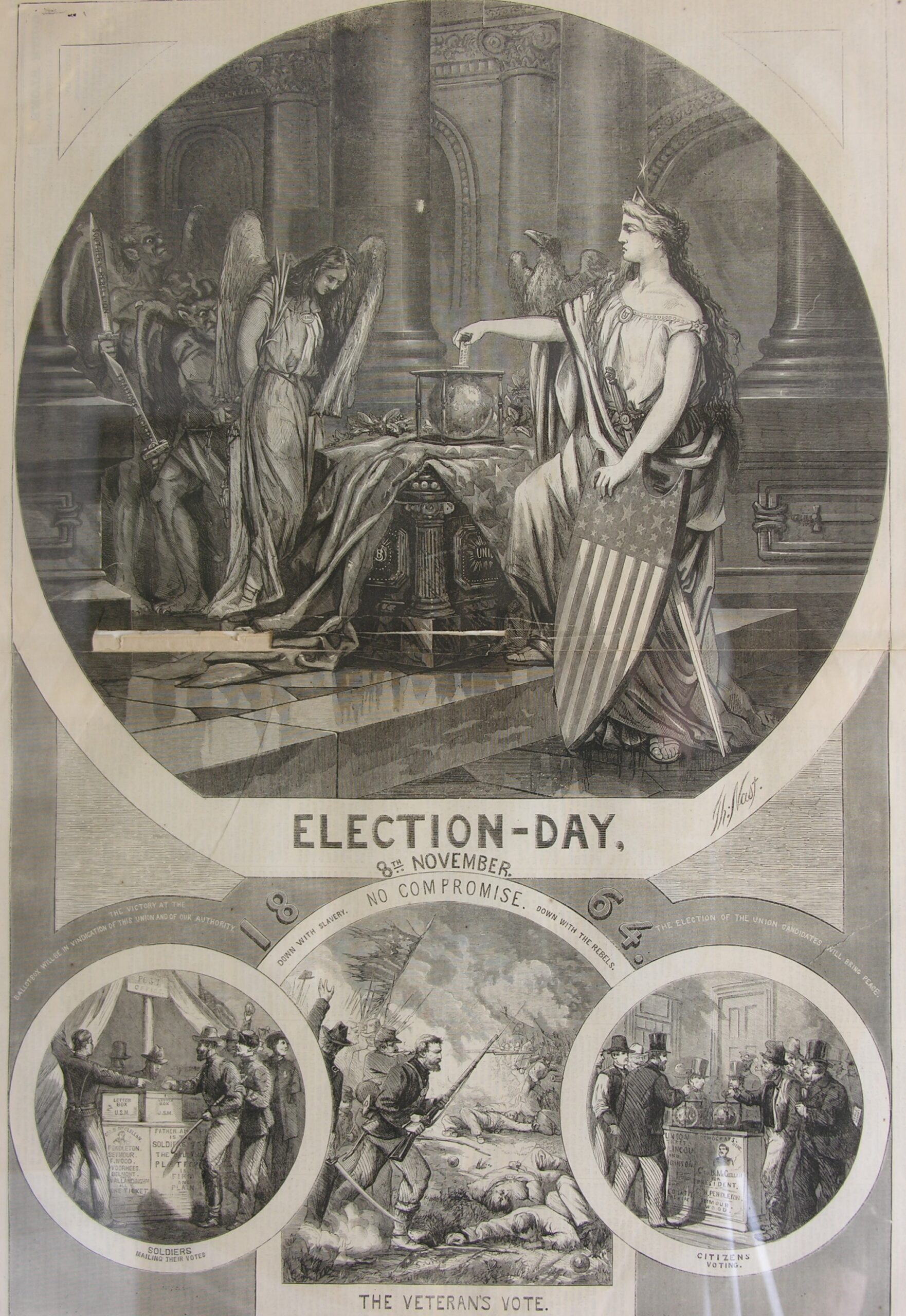
Thomas Nast / Proof / Harper’s Weekly / December 24, 1881
The children ready to hang their stockings on the mantel of the fireplace ask their dog, “Don’t you wish you wore stockings?” in the hopes that Santa Claus would fill them with gifts and treats. The little pug looks at the girl lovingly.
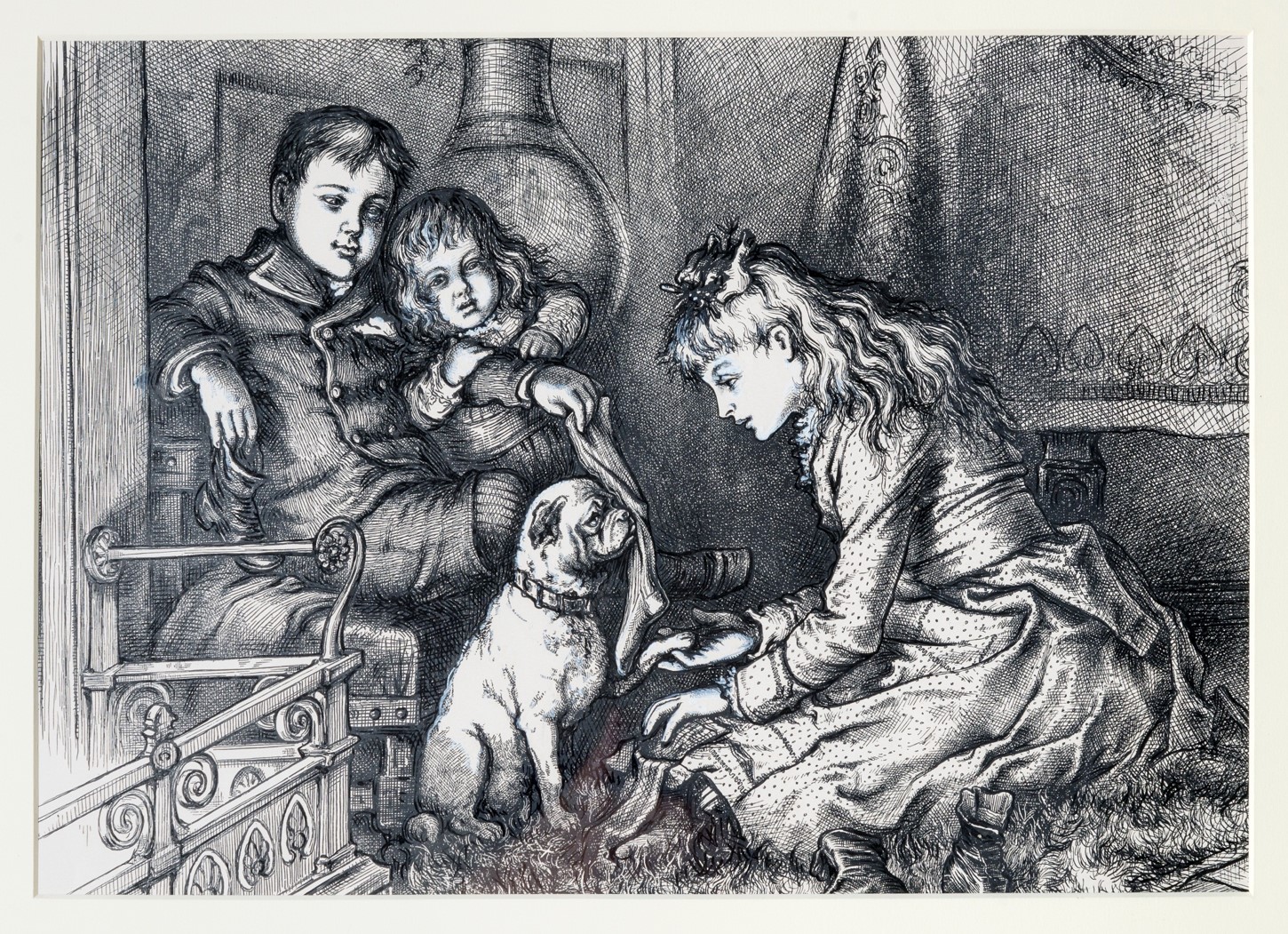
Thomas Nast / Engraving / Harper’s Weekly / December 27, 1879
This picture marks the first time that the Republican Elephant and Democratic Donkey symbols appear together in a Thomas Nast political cartoon. Democratic Senator Thomas Bayard, an advocate of “hard money,” is shown holding onto the tail of the Donkey to keep it from falling over the edge into financial chaos. Republican John Sherman, chairman of the Senate Finance Committee, whose position on the issue was equivocal, stands beside a slumbering elephant, satisfied with the status quo. The caption reads: Senator “Hold on, and you may walk over the sluggish animal up there yet.”
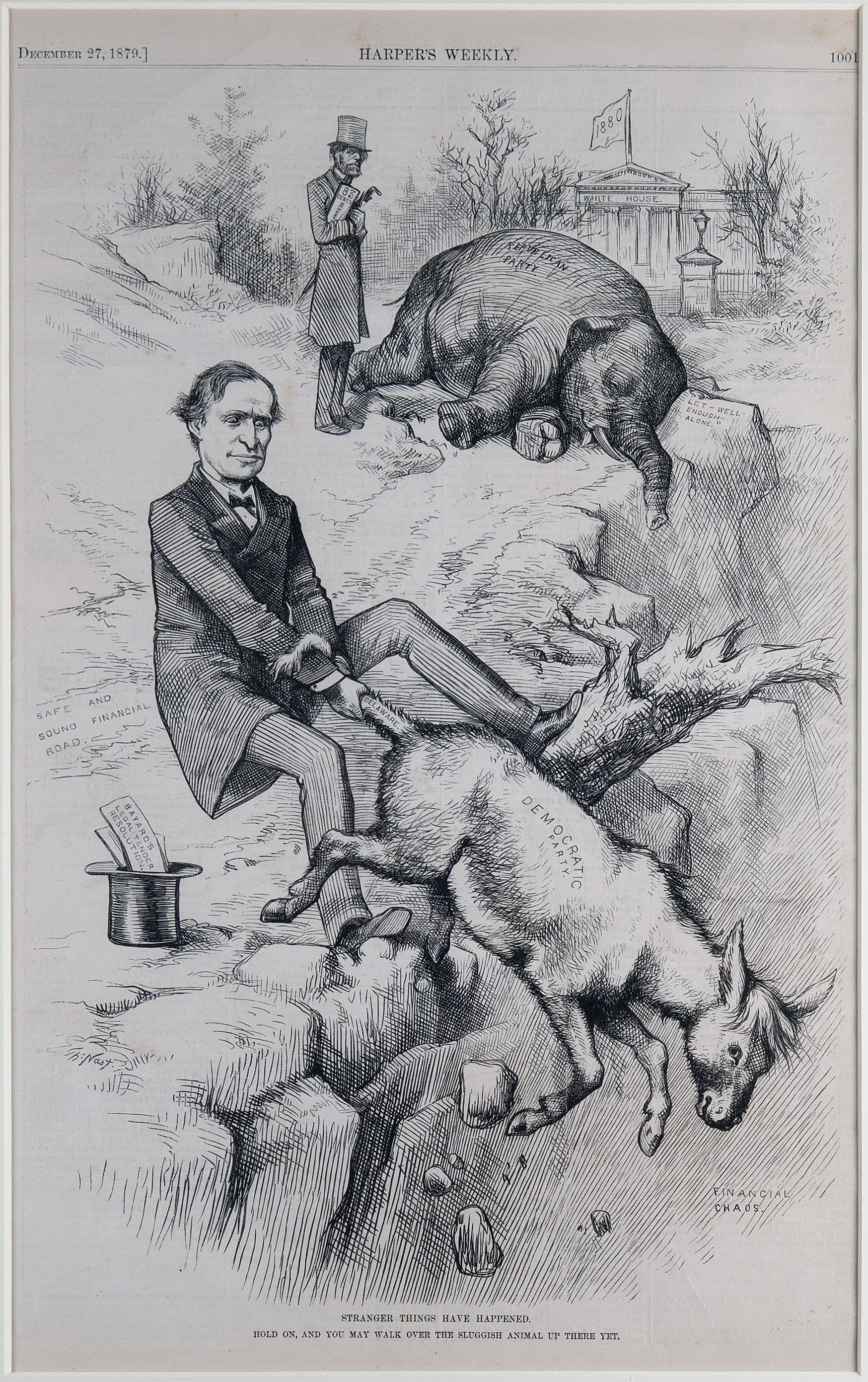
Stranger Things Have Happened
Thomas Nast / Engraving / Harper’s Weekly / October 24, 1863
Thomas Nast depicts the Civil War spy in nine different scenes. In the top left corner, “In The Enemy’s Works”, left center “Booty”, lower left corner “In Pursuit”, in the top right corner “Who Goes There”, right center “Safe Return”, lower right corner “Telling His Adventure”, top center “Suspected”, the center panel reveals his face, and the lower center “Sentenced” (hanging from a tree).
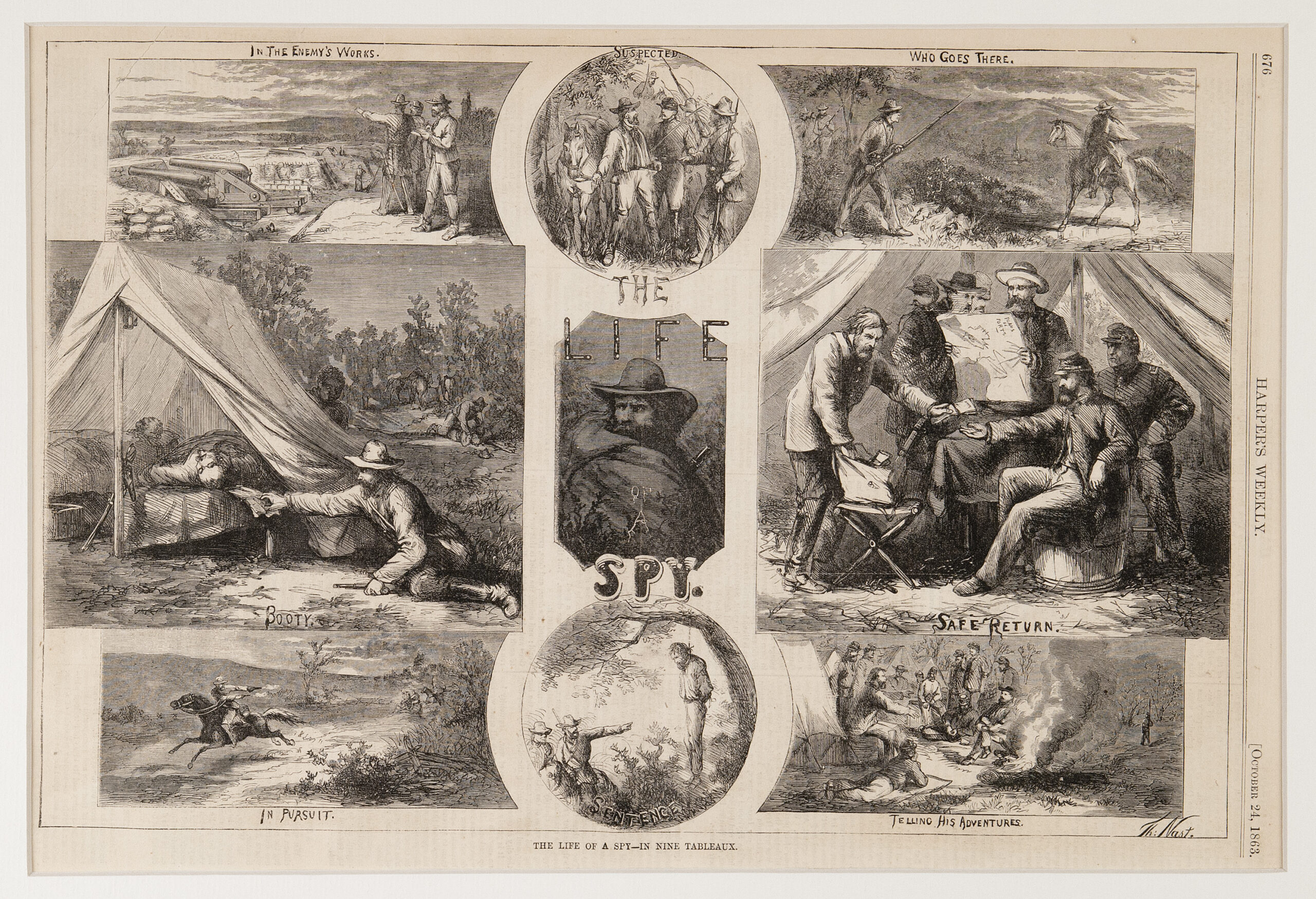
Thomas Nast / Engraving / Harper’s Weekly / January 27, 1872
Thomas Nast’s Shakespearean characters appeared in Harper’s Weekly on a regular basis through the early 1870’s, depicting various political figures. In this engraving, Nast shows Boss Tweed as Julius Caesar, being stabbed by the Governor of New York, John T. Hoffman (Brutus). The sword reads “message” as to send a message to the Boss. Governor Hoffman, former mayor of New York City was once part of Tweed’s inner circle. Hoffman was the puppet of the Tweed Ring both as Mayor of New York City and as Governor of the state. Hoffman was so closely associated with Tweed and the Tammany corruption that he was forced out as Governor in 1872 when this image appeared.
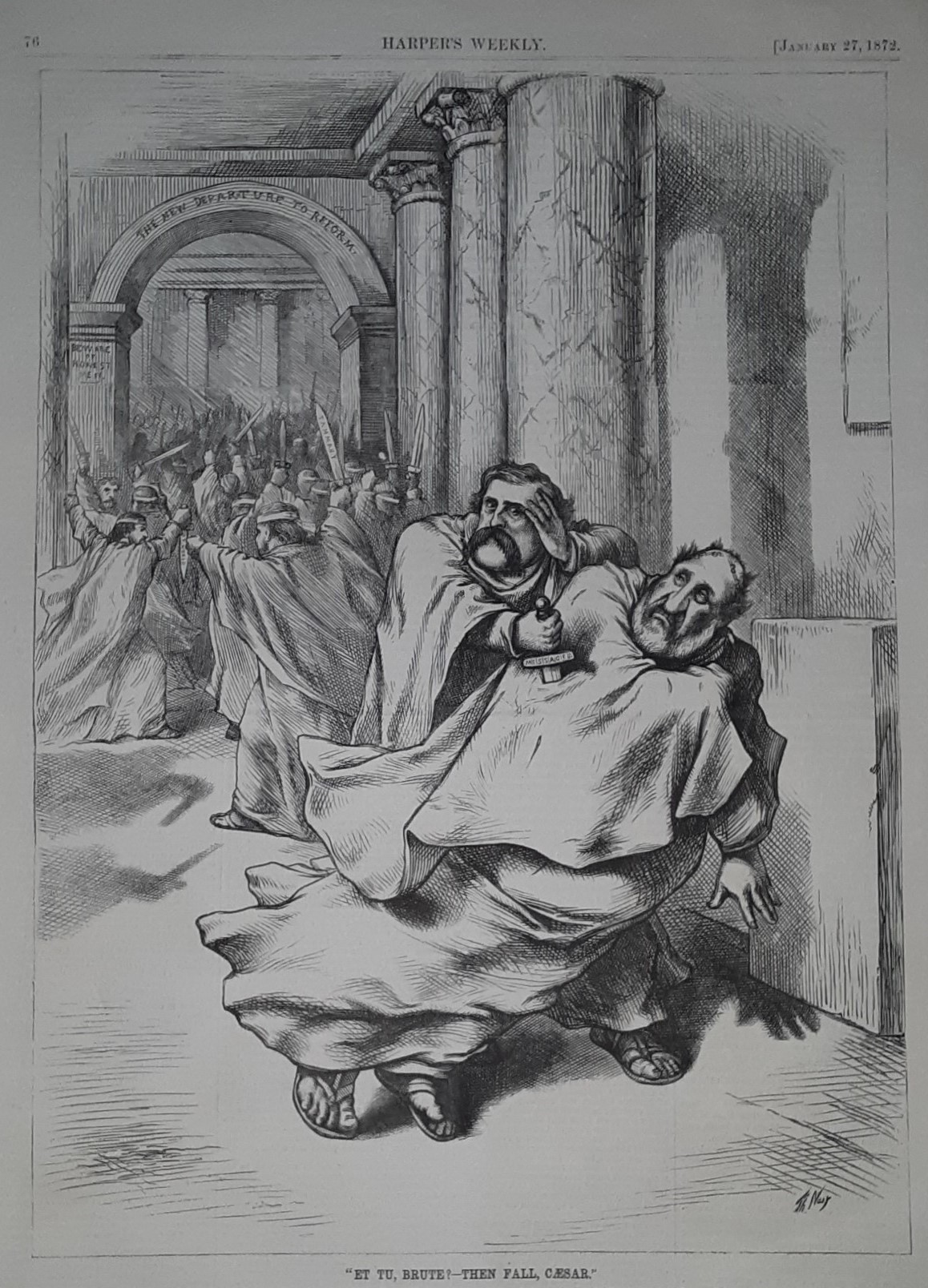
Thomas Nast / From the Book "Miss Columbia’s Public School: or Will It Blow Over? By A. Cosmopolitan / With 72 illustrations by Thomas Nast / Published by Francis B. Felt & Co. / New York 1871
This image was published in the book Miss Columbia’s Public School: or Will It Blow Over?. The book focused on domestic issues facing the United States at the time. Nast and author A. Cosmopolitan, also known as Charles Henry Pullen, emphasized the need for the separation of church and state in the United States, among other issues. Nast depicts Columbia here appealing for equal rights for all people.
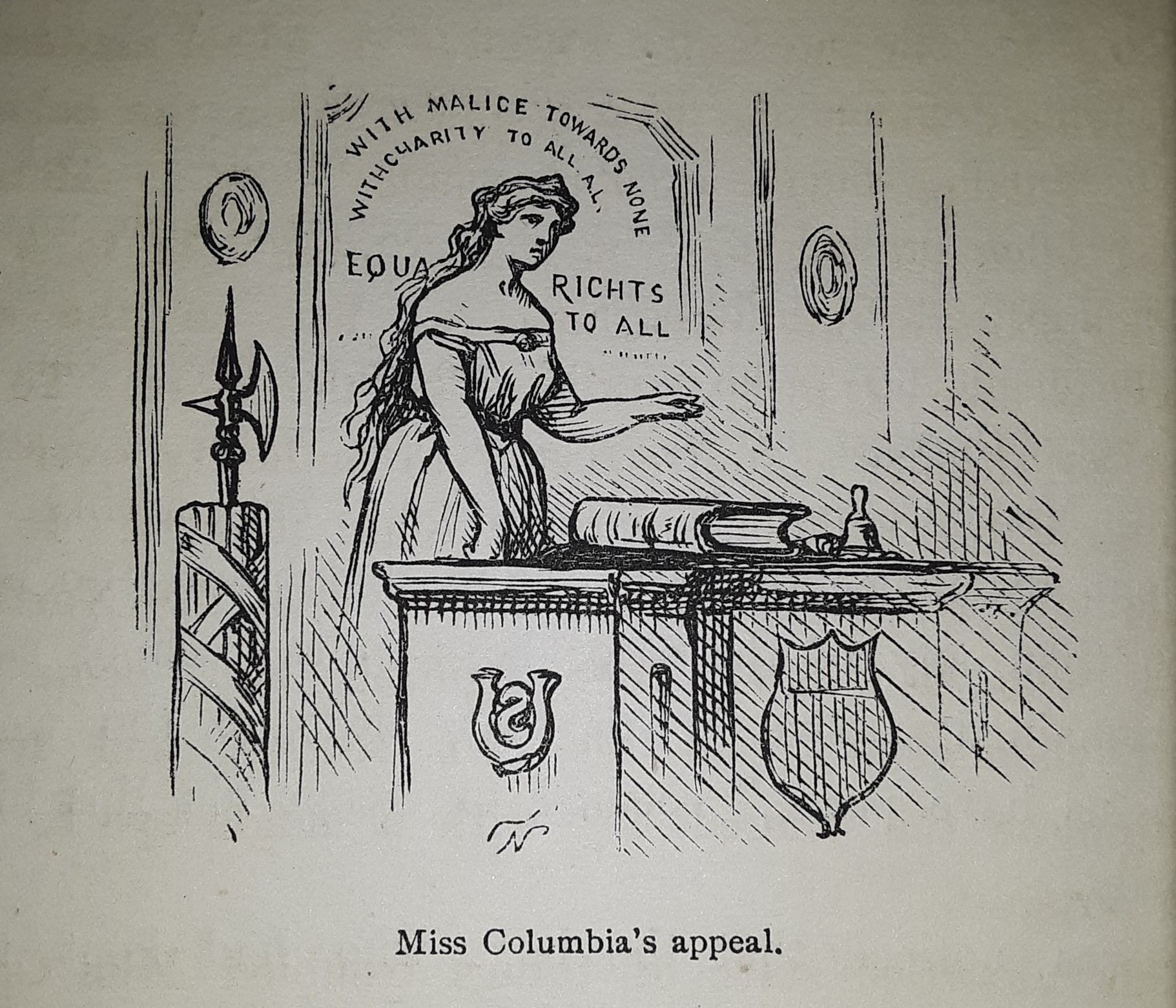
Thomas Nast / Engraving / Harper’s Weekly / December 18, 1886
This cartoon is the last one Nast drew for Harper’s Weekly featuring the image of Columbia before ending his full-time career at the publication in January 1887. Nast illustrates Columbia and Uncle Sam approaching Congress. Uncle Sam struggles under the weight of a bag captioned $125 million “annual surplus.” Columbia, carrying a scroll titled “Cleveland’s Message to Congress,” warns “Don’t overtax yourself, for it only leads them into temptation.” Columbia refers to Congress as she warns not to overspend or raise taxes because of the government’s misuse of money.
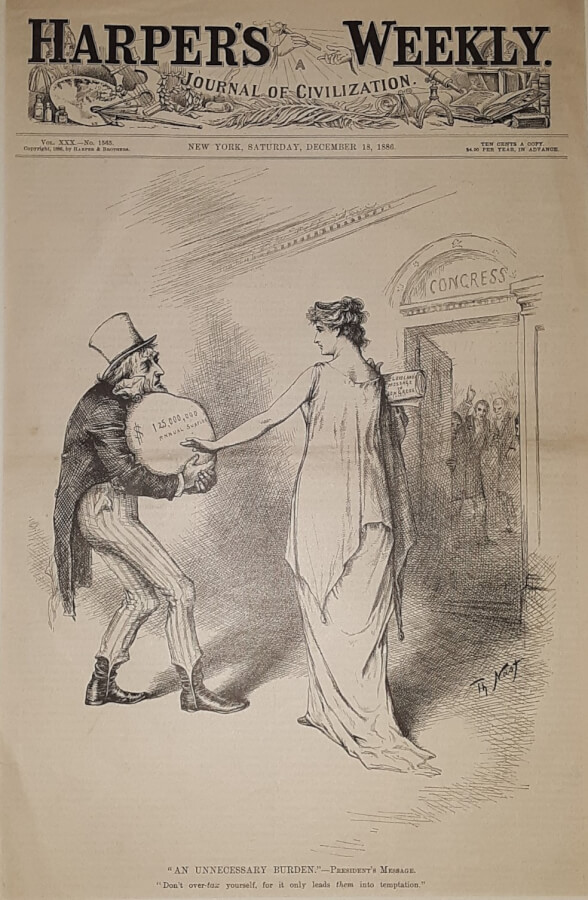
Thomas Nast / Engraving / Harper’s Weekly / March 7, 1885
This cover image can be seen as the passing of the torch from President Chester A. Arthur to the new President, Grover Cleveland. Columbia is seen in the background linking the two men with her virtue and moral strength. Both men were champions of civil service reform and battled against corrupt politicians. Cleveland had a high level of respect for Arthur because they shared many moral and political philosophies and goals.
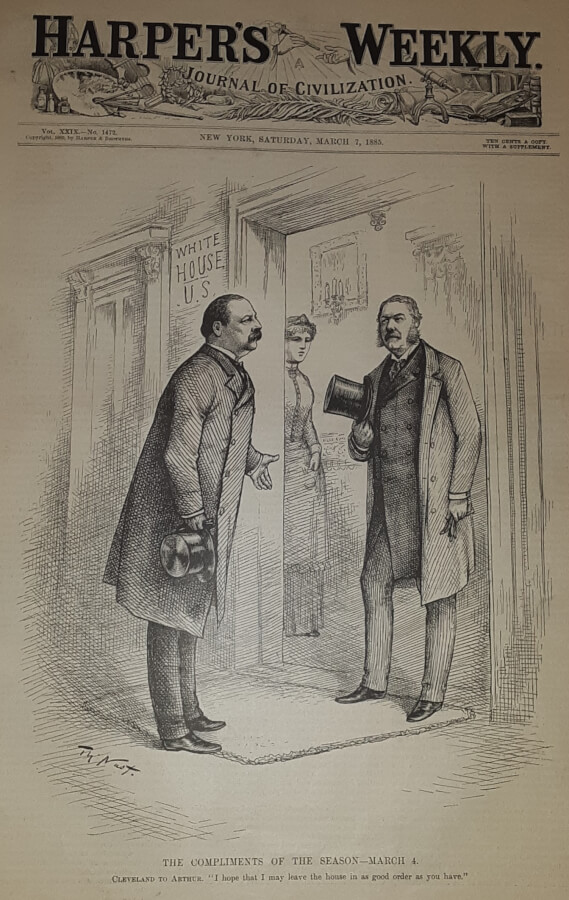
Thomas Nast / Harper’s Weekly / August 31, 1872 / Engraving
Uncle Sam looks on disapprovingly as presidential hopeful Horace Greeley paints over the Tammany Tiger with his “reform white wash.” The strips on the tiger are labeled “Corruption”, “Illegal Voting”, “Whole Sale Robbery” and “Tammany Ring.” The incumbent and Civil War hero, Ulysses S. Grant, was reelected and sadly Horace Greeley passed away soon after the election on November 29, 1872.
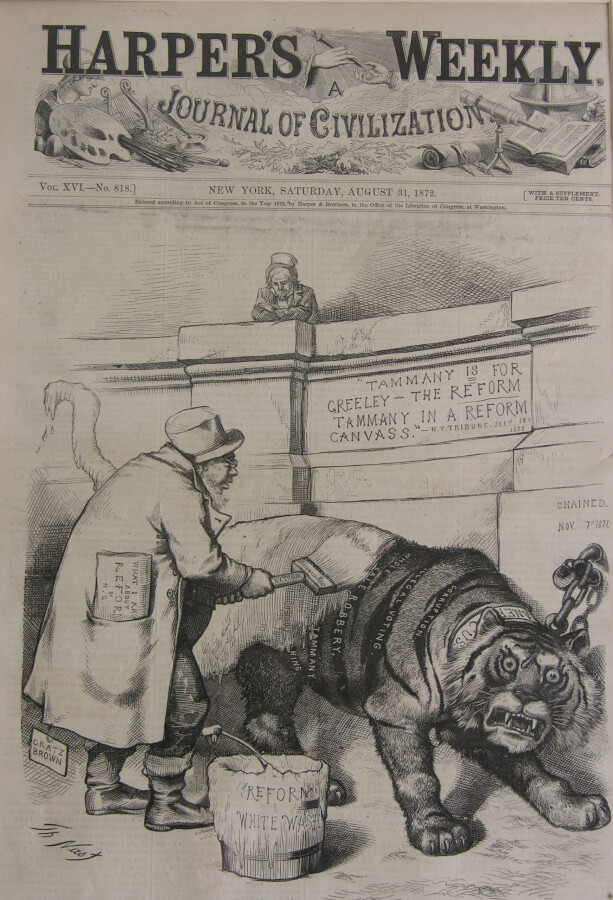
Engraving / Harper’s Weekly / January 1, 1881
Thomas Nast’s humor is on display in this post-Christmas image. People may feel like this boy and wish Christmas came oftener, but as the sign in the window says “Christmas comes but once a year therefore lets be Merry.”
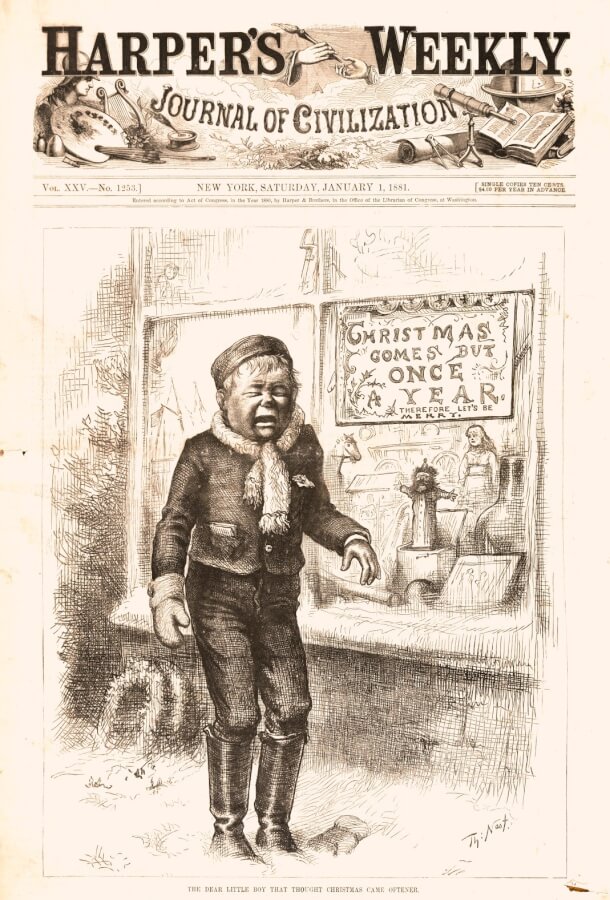
Thomas Nast / Engraving / Harper’s Weekly / October 2, 1869
Thomas Nast’s sense of humor is evident as he compared the college student of the past as thin, reading and surrounded by large books in a cobweb filled room while the present-day college student, in 1869, was not only concerned with his studies but also with being healthy and physically fit. The drawing promoted college athletics along with academic studies. Nast’s beliefs of health discouraged the practices of smoking and drinking.
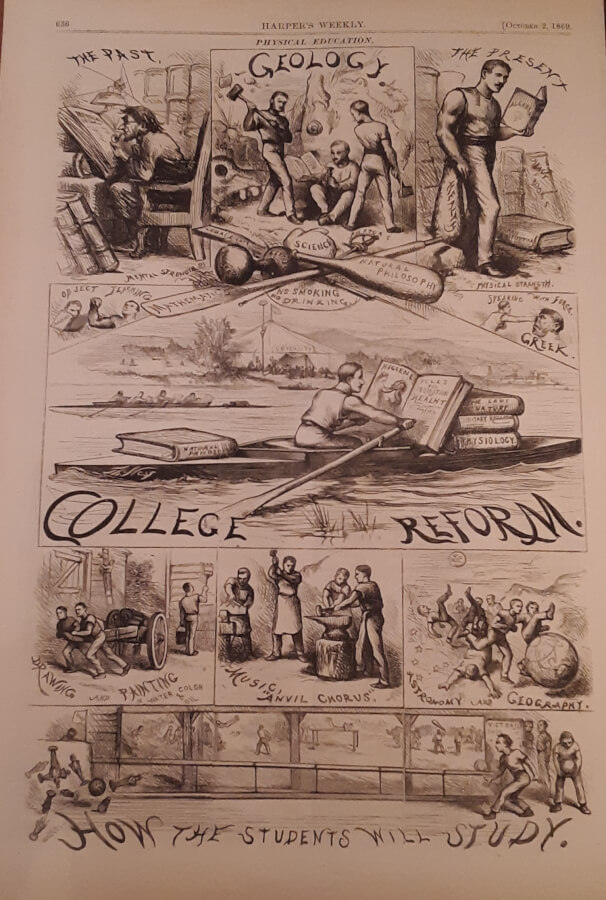
Thomas Nast / Engraving / Harper’s Weekly / October 21, 1871
This is an iconic Thomas Nast image of Boss William M. Tweed. Over six feet tall and nearly 300 pounds, Tweed was an easy target for Nast’s caricature. The Boss’s ever-present diamond shirt stud grows out of proportion as well. A sack of money, in place of the Boss’s head was an unmistakable message that could be understood by all. Nast’s images of Tweed in the early 1870s helped bring him to justice.
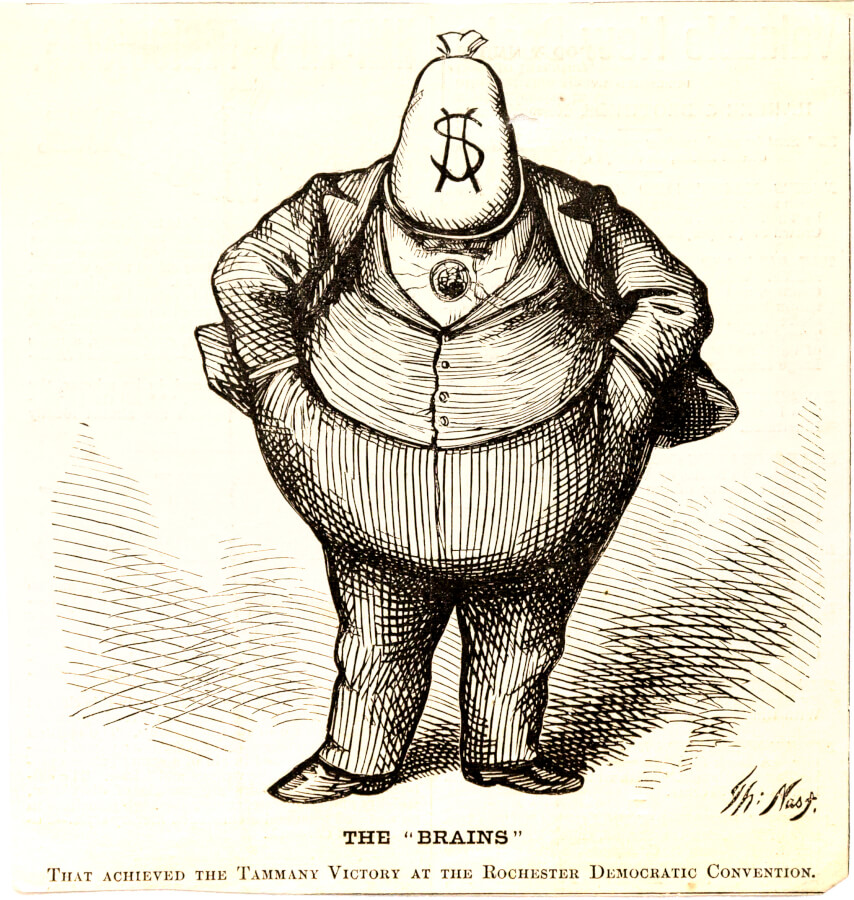
Thomas Nast / Engraving / Harper’s Weekly, December 26, 1863
This Civil War Christmas image by Thomas Nast depicts Santa Claus as a smaller figure coming out of the fireplace and kneeling on a chair to make sure the children are asleep before he leaves the Christmas gifts on Christmas Eve. The main vignette in the center depicts a soldier’s reunion with his family as he returns home from war to celebrate the holiday.
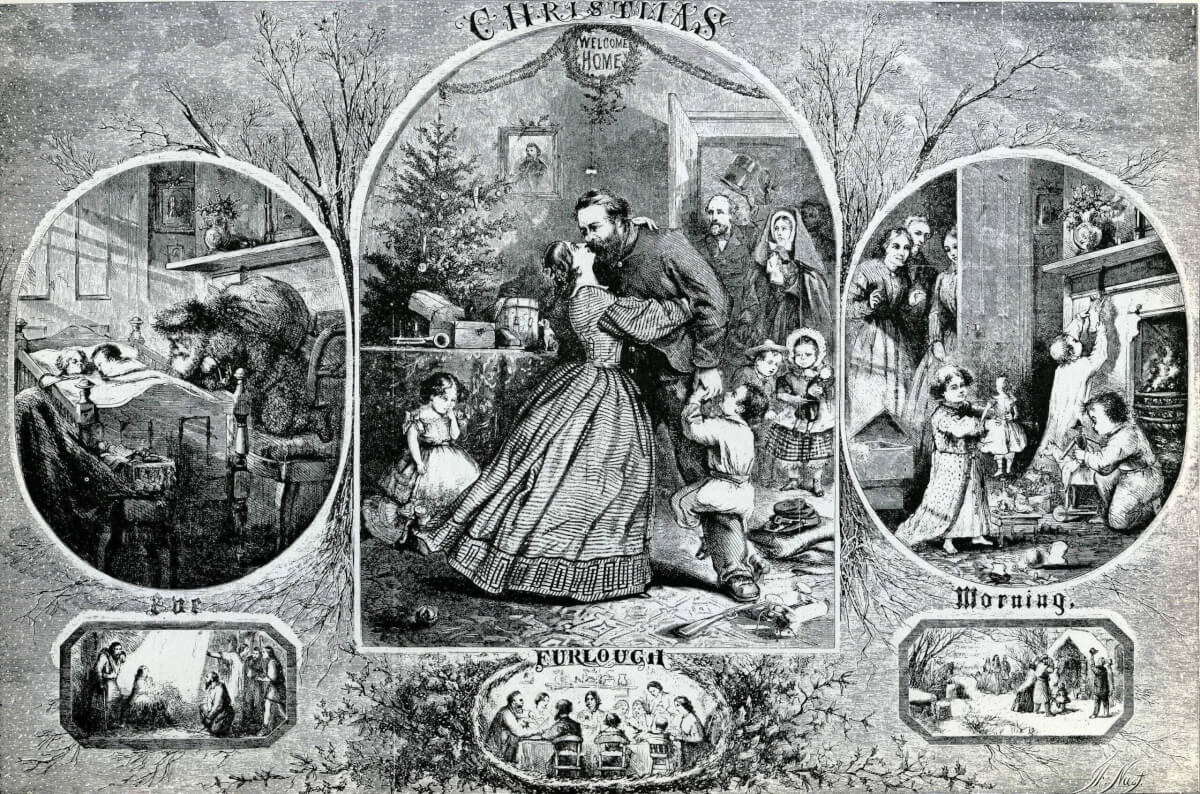
Thomas Nast / Engraving / Once a Week: An Illustrated Weekly Newspaper / July 15, 1893
Macculloch Hall Historical Museum celebrates baseball season with this engraving by Thomas Nast. The Museum also owns a pencil study of the image by Nast. The pencil and published copies are almost identical. This engraving is from Once a Week: An Illustrated Weekly Newspaper. Nast is best known for his work at Harper’s Weekly, but he did have political cartoons published in over 65 different periodicals including Once a Week. Below is a transcription of the words on the engraved published image: “For Artistic Posing And Effect, There Is Nothing Like A Study Of Instantaneous Photography Especially During The Base Ball Season Th: Nast. 1893”

Thomas Nast / Engraving / Appeared in Harper’s Weekly, January 3, 1885
This is a classic portrait of Santa Claus by Thomas Nast. The pen of the famous political cartoonist, Thomas Nast, popularized the image of Santa Claus as we know him today. Nast’s image of Santa Claus as a jolly, round-bellied, white bearded figure immediately captured the imagination of both children and adults throughout the nation and helped Nast earn his fame. His drawing of Santa was first published on the front page of Harper’s Weekly in 1863 and continued to appear in the magazine almost every Christmas season for more than twenty years.
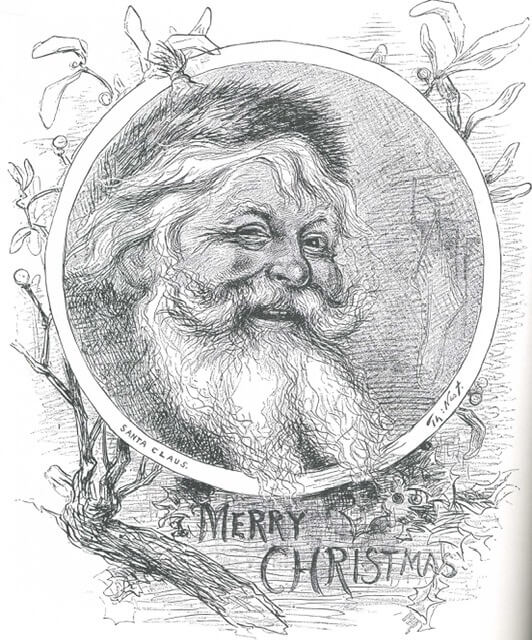
Engraving / Harper’s Weekly / December 30, 1871
Thomas Nast portrays Santa Claus reading the letters sent by parents about the girls and boys. Santa has 2 piles for the lists, the very tall pile of “Letters From Naughty Children’s Parents” and the smaller pile of “Letters From Good Children’s Parents.” The humor of Nast is displayed here. The pictures on the wall behind Santa correspond with the the piles of letters, depicting naughty and nice children accordingly.
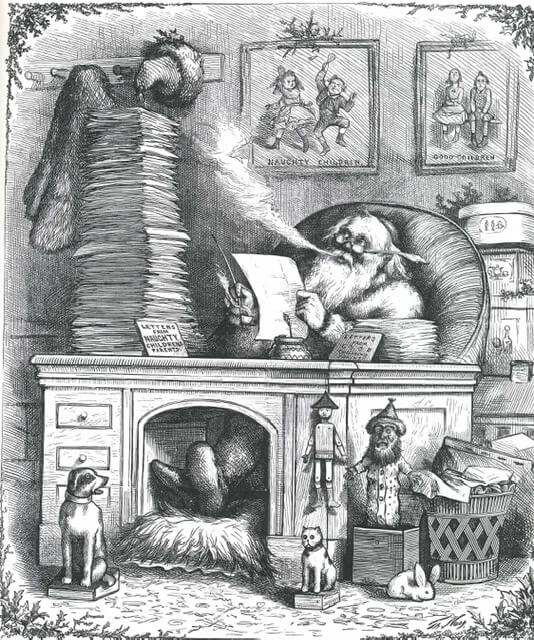
Thomas Nast / Engraving / Harper’s Weekly / April 9, 1864
The U.S. Sanitary Commission became an official agency in June, 1861, soon after the start of the Civil War. The fervor of patriotism in the North is evident in the outpouring of support for this commission. For the first year of its existence, private contributions to the Sanitary Commission were no less than $9 million of the needed $11 million in supplies. The women who worked for the commission were very important in getting medical supplies and creating a healthy atmosphere for the soldiers in battle. As Thomas Nast calls them in the image, they were “Our Heroines” of the Civil War.
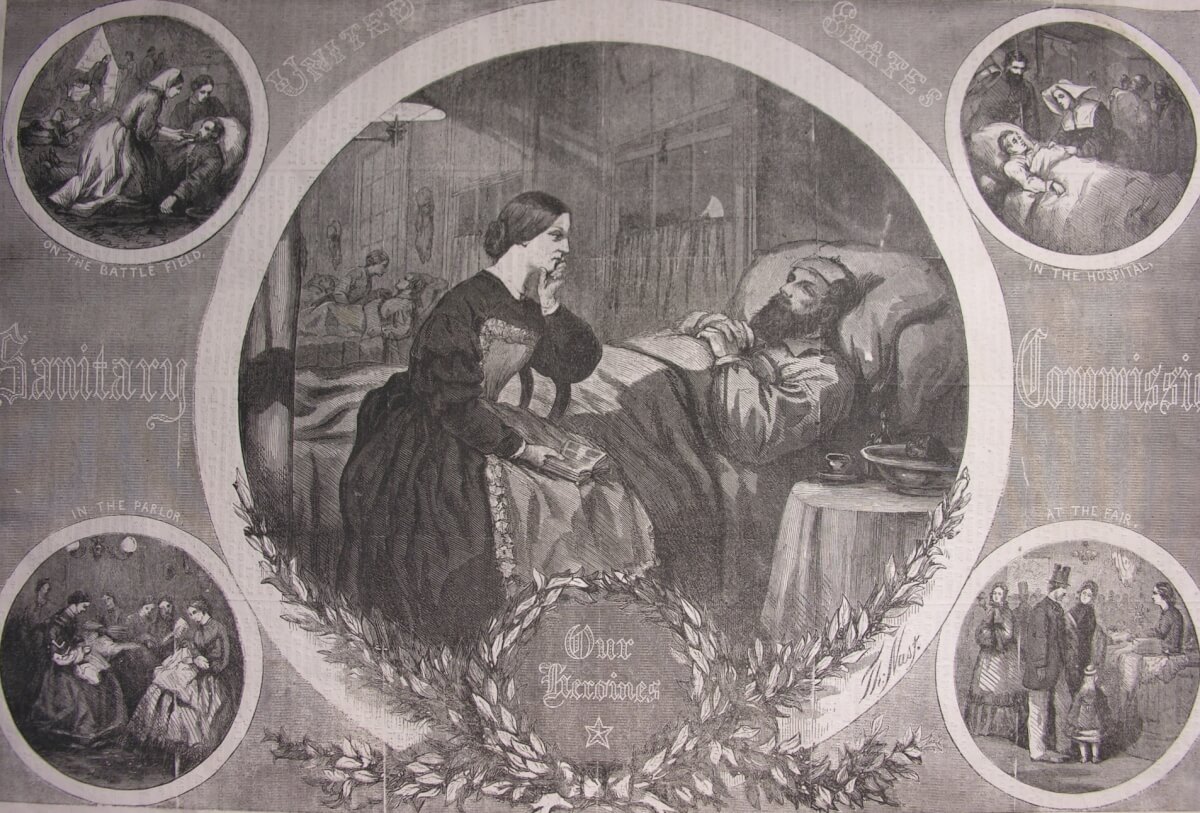
Thomas Nast / Engraving / Harper’s Weekly / July 16, 1864
Thomas Nast published this patriotic image for the Fourth of July during the Civil War in 1864. The center and largest vignette depicts Columbia, a symbol of the United States, with the flag, as “The Protector of all Rights”, as labeled beneath the picture. The various other surrounding vignettes display scenes of the flag during the Civil War.
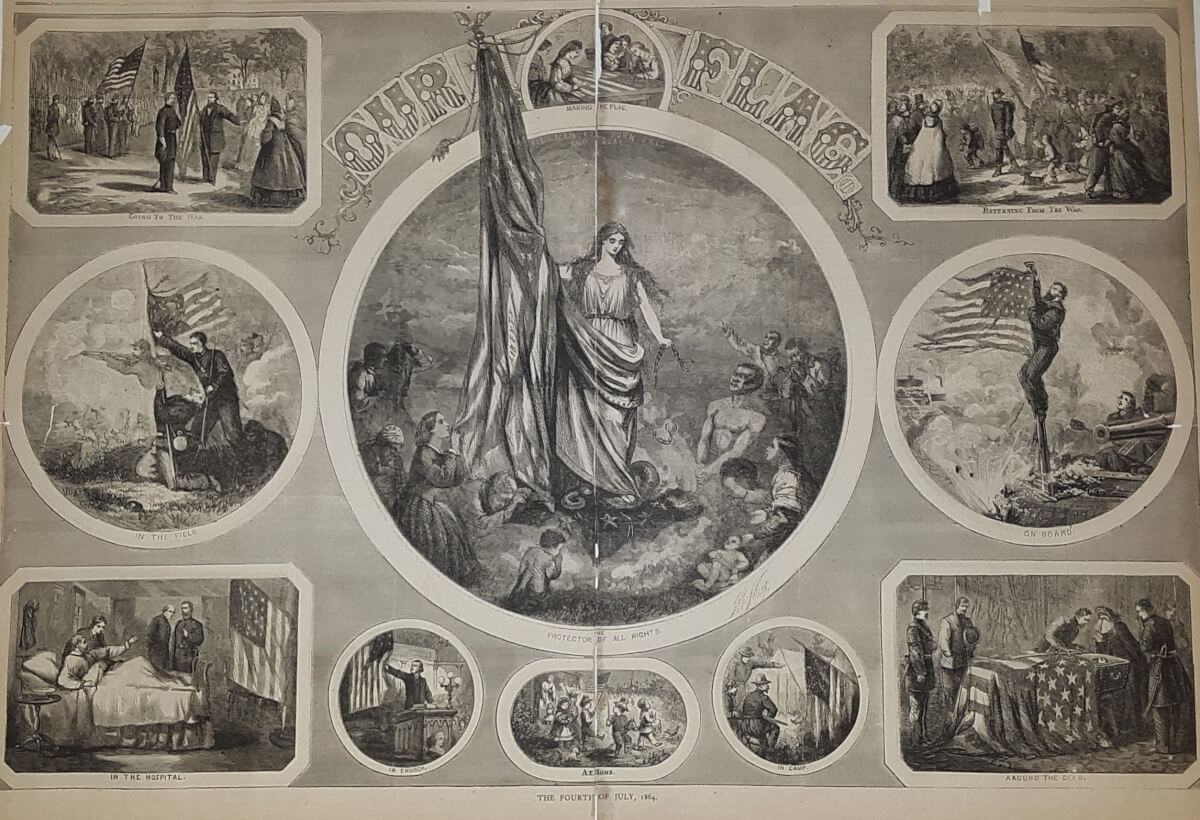
The Emancipation of the Negroes, January, 1863-The Past and the Future
Thomas Nast / Engraving / Harper’s Weekly / January 24, 1863
During the Civil War President Abraham Lincoln issued the Emancipation Proclamation. It declared “That on the first day of January, in the year of our Lord one thousand eight hundred and sixty-three, all persons held as slaves within any State or designated part of a State, the people whereof shall then be in rebellion against the United States, shall be then, thenceforward, and forever free…”
Thomas Nast created Emancipation in support of the President’s Proclamation. Nast depicted vignettes showing some of the horrors enslaved people faced, on the left side of the engraving. The artist displayed the public sale and torture of African American enslaved people. On the right side Nast drew his hope for the future of enslaved people. African American children are shown attending public school and African American adults receiving wages for their labor.
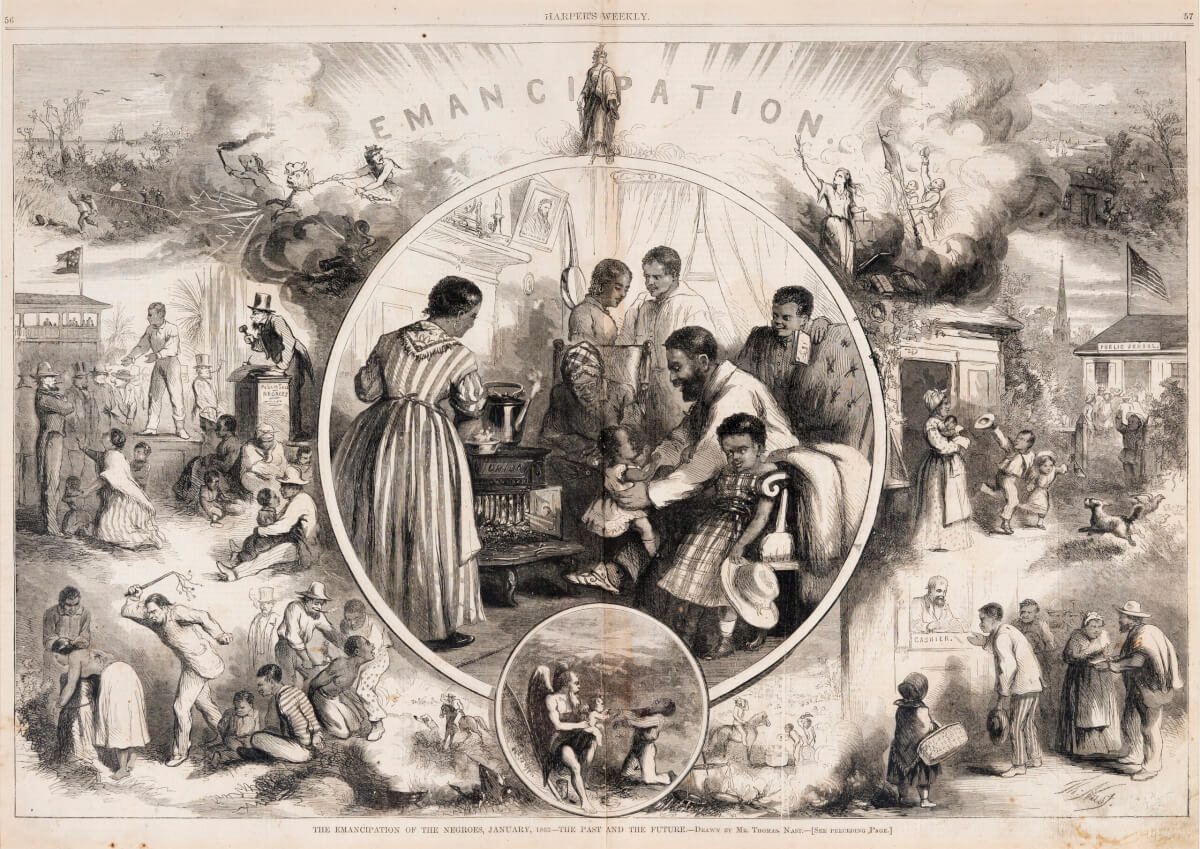
Thomas Nast / Engraving / Harper’s Weekly / June 6, 1868, Cover / Originally appeared as Thanks to Grant on February 6, 1864
Harper’s Weekly opened the presidential campaign of 1868 with the reprinting of this political cartoon first published on February 6, 1864. The Republican Party nominated General Ulysses S. Grant (1822-1885), who was a hero to many for his service in the Civil War. Nast first drew this image titled as Thanks to Grant in honor of Grant’s loyalty to the Union. The 1868 reprinting of this image was re-titled Chicago, the location of the Republican Convention of 1868.
Nast illustrates the figure of Columbia pinning a medal onto Grant’s uniform. Together they stand in front of the altar of the Union on which Columbia rests her shield and sword. Re-framing this scene, Nast turns an image of thanks into one of campaign support endorsed by Columbia.
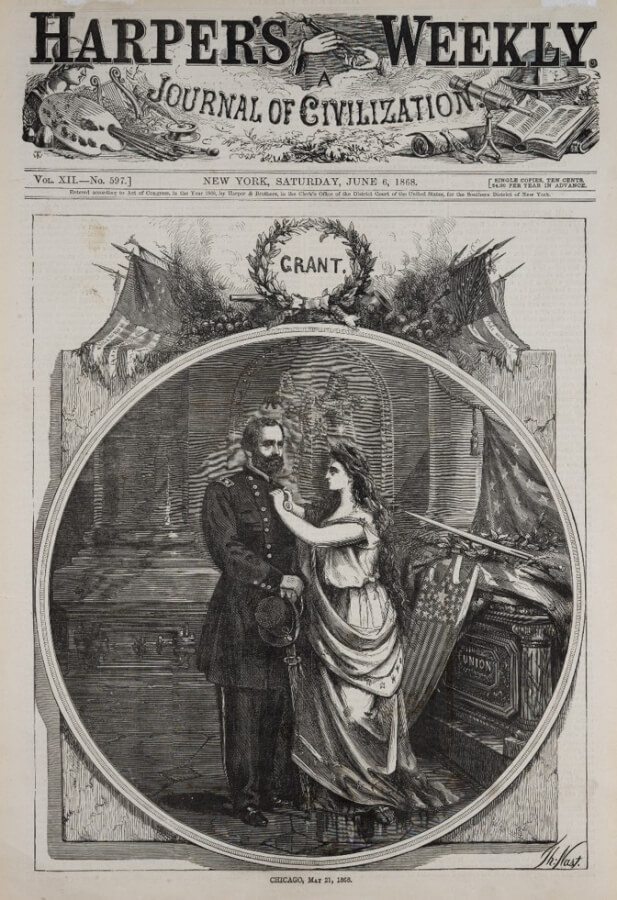
Thomas Nast / Harper’s Weekly / November 24, 1877 / Engraving
This iconic image of Uncle Sam is likely the most well-known image of the figure by Nast. Throughout his career at Harper’s Weekly, Nast was a big supporter of the U.S. armed forces and continually fought for their funding. Astride the snail of Congress and the Army and Navy payroll in hand, a grim Uncle Sam expresses his irritation with economic-minded legislators for being too slow to provide much-needed military funding.
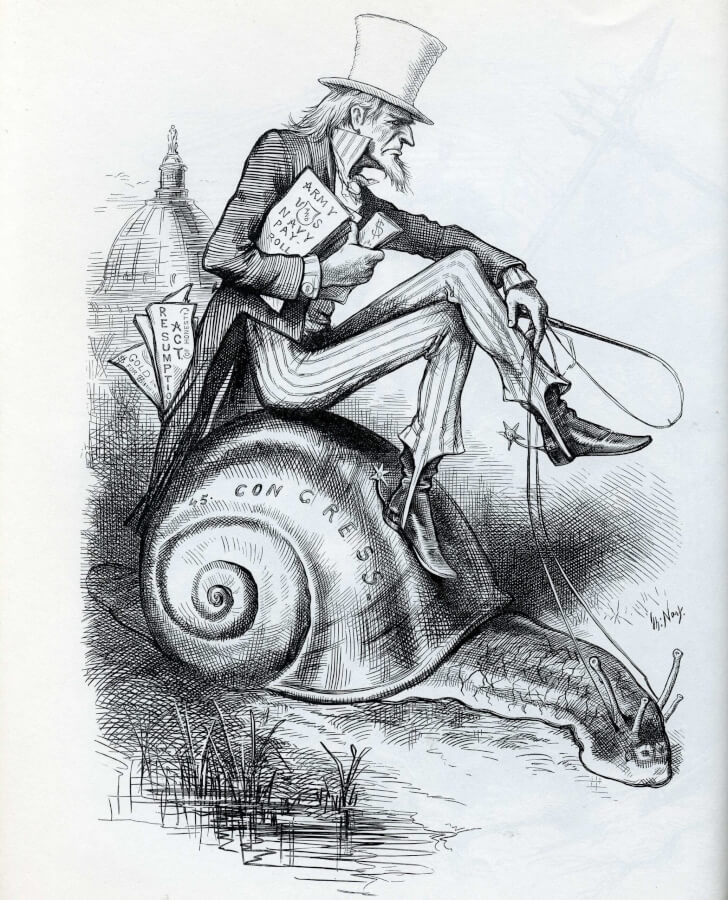
Thomas Nast / Engraving / Harper’s Weekly / January 6, 1872
During the early 1870s, William “Boss” Tweed often appeared to the public as if he were above the law. Nast depicts the law as the average-sized police officer able to apprehend lowly “dwarf” criminal but not Tweed, the “giant thief” who is untouchable by the law.
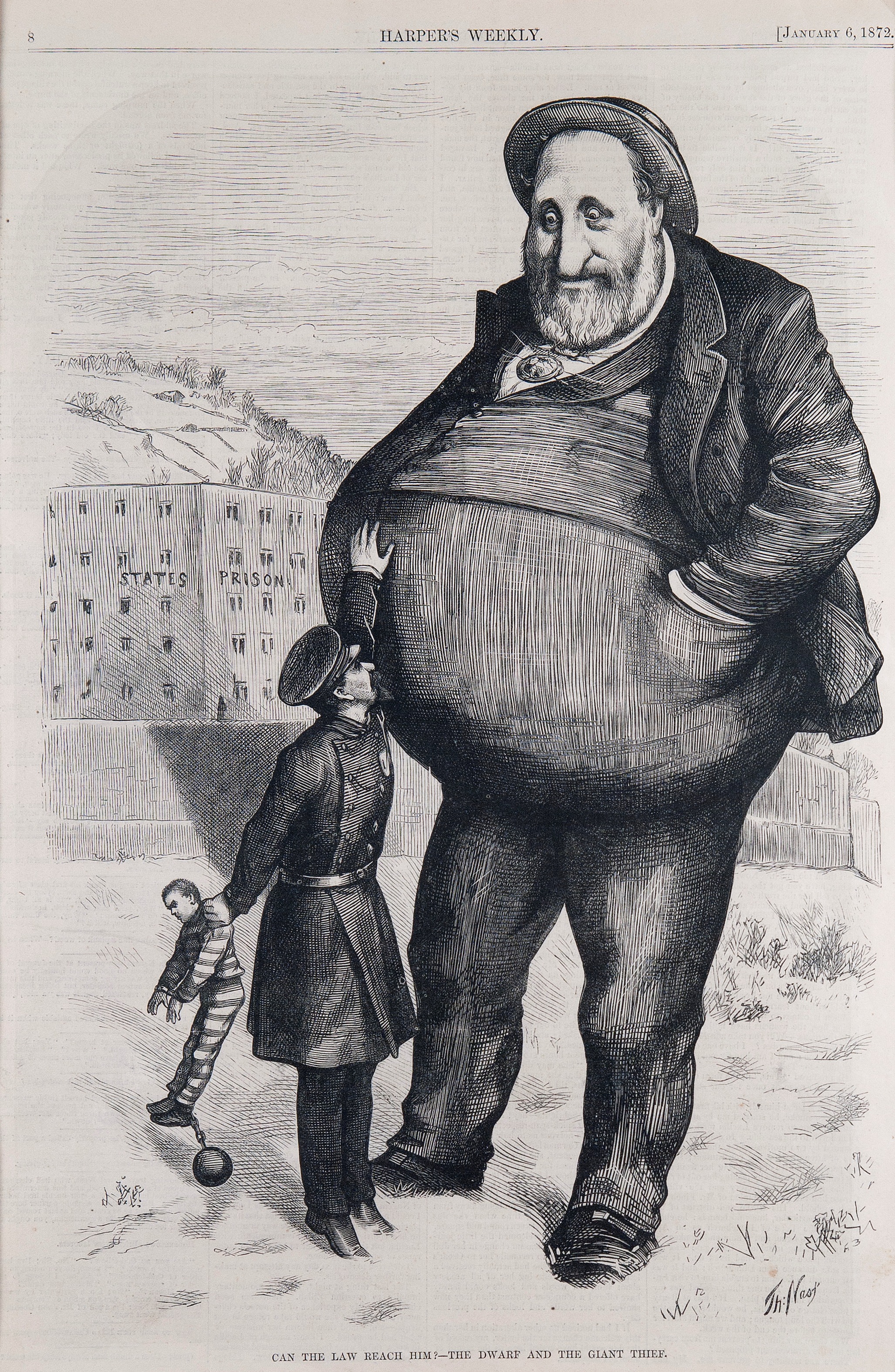
Can the Law Reach Him? - The Dwarf and the Giant Thief
Thomas Nast / Artist’s proof / Published in Harper’s Weekly / December 19, 1863 / Photograph by Stan Freeny
Thomas Nast depicts the life of a young drummer boy during the Civil War in eight vignettes. This propaganda image was drawn to set parents fears at ease and to encourage them to send their young boys to war to fight for the Union cause. In the center left, the boy leaves the family home wiping his tears as his mother and grandmother weep. In the scene to the right, the drummer boy returns from war fearless and proud. The surrounding vignettes show how the boy will be taken care of, stay fed and clean in camp, how he will write home and finally how he will bravely lead the troops into battle.

Thomas Nast / Pencil on Paper / 1862 / Photograph by Stan Freeny
In 1862 Thomas Nast drew this touching picture of his wife Sarah, or Sallie as he called her, and their first born child Julia. Nast was proud of his new family. Thomas and Sallie were married in September of 1861 and their daughter Julia was born the following July.
Nast had recently returned from Europe in February 1861 at the young age of 20. He had followed Giuseppe Garibaldi’s campaign to unify Southern Italy. While in Italy, and after while touring Europe, he studied some of the old masters, including Raphael Sanzio (1483-1520) and others who painted versions of the Madonna and Child. Nast was inspired by these artists of past and their influence is seen in this “modern” 19th century take of Mother and Child.
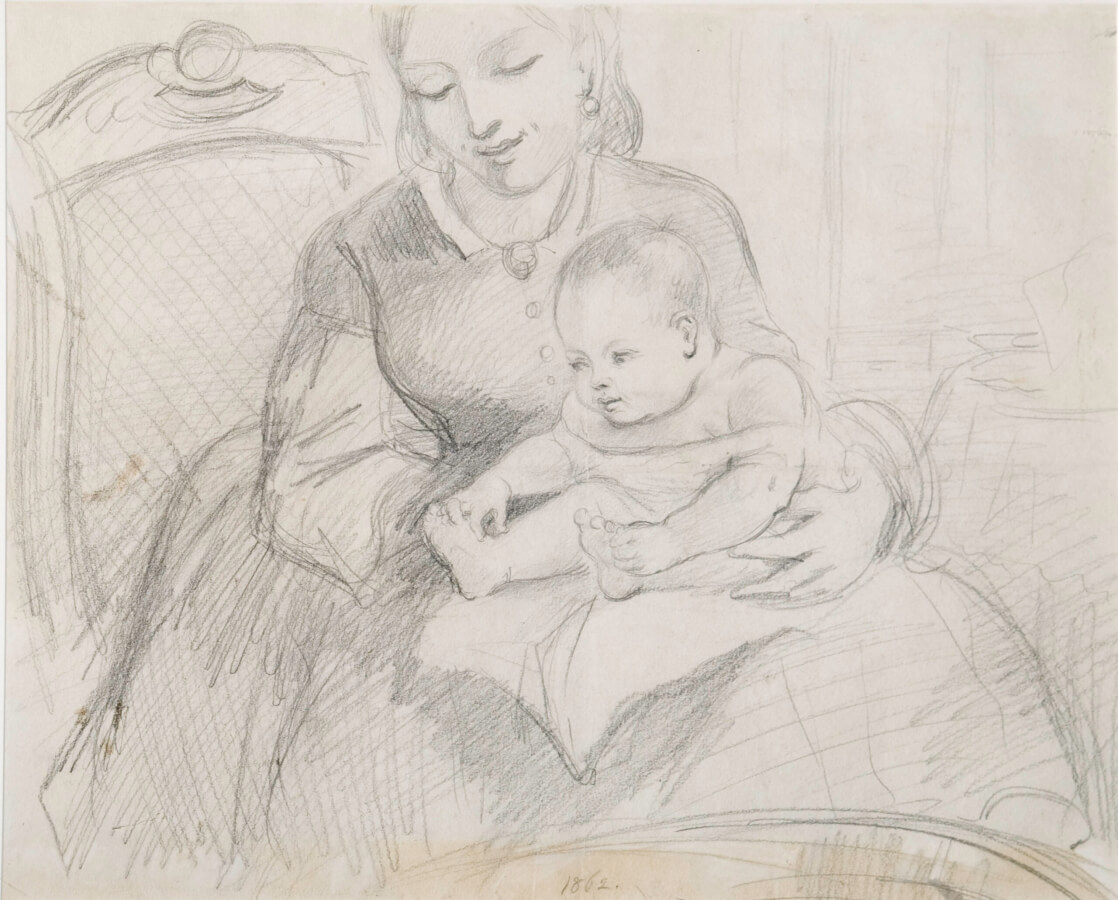
Thomas Nast / Engraving / Harper’s Weekly / July 11, 1863
The drummer boys of a Union Camp, during the Civil War, play their drums to awaken the Northern troops to the military beats. Thomas Nast drew this image to depict military life in camp. Nast liked to draw drummer boys, because it showed bravery at such a young age. Nast felt that this would stir emotions and support for the Union Army. The artist would create pictures from the battlefield, from camp as well as the families back home during the War.
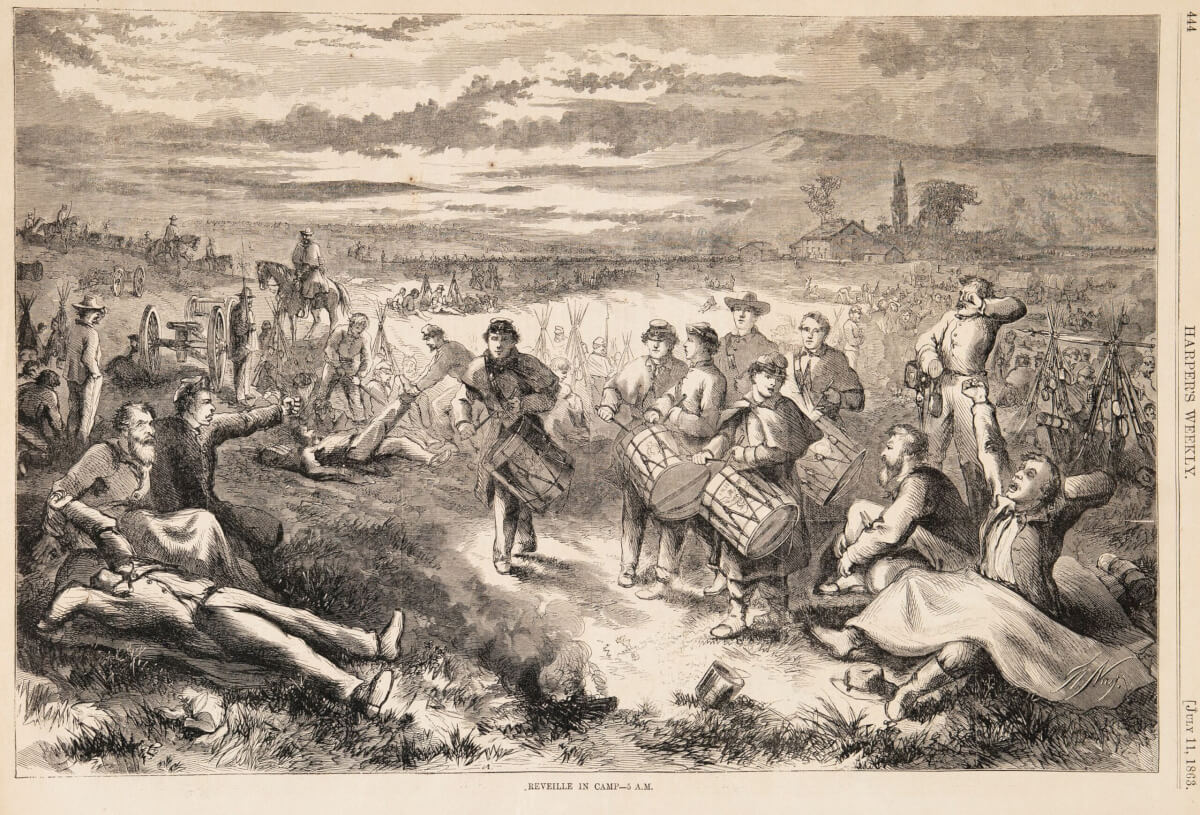
Thomas Nast / Engraving / Harper’s Weekly / September 20, 1862, Cover
A Gallant Color-Bearer is one of Thomas Nast’s first images for Harper’s Weekly during the Civil War. Many of the artist’s drawings during the war were patriotic images intended to stir emotions to support the Union cause. The below is an article from the same issue of Harper’s Weekly about the inspiration for Nast’s cover image.
“H. Alexander, color-bearer of the 10th New York Regiment deserves to be placed high upon the roll of our heroes. He received 3 terrible wounds in a recent engagement, but clung to his colors with tenacious grasp. While being taken into hospital he became inservicable, and an attempt was made to take the flag away, but his unconcious hand held it more powerfully; even then his ruling passion was strong. Such men in life and death are glorious examples. Our picture is a just homage to distinguished gallantry.”
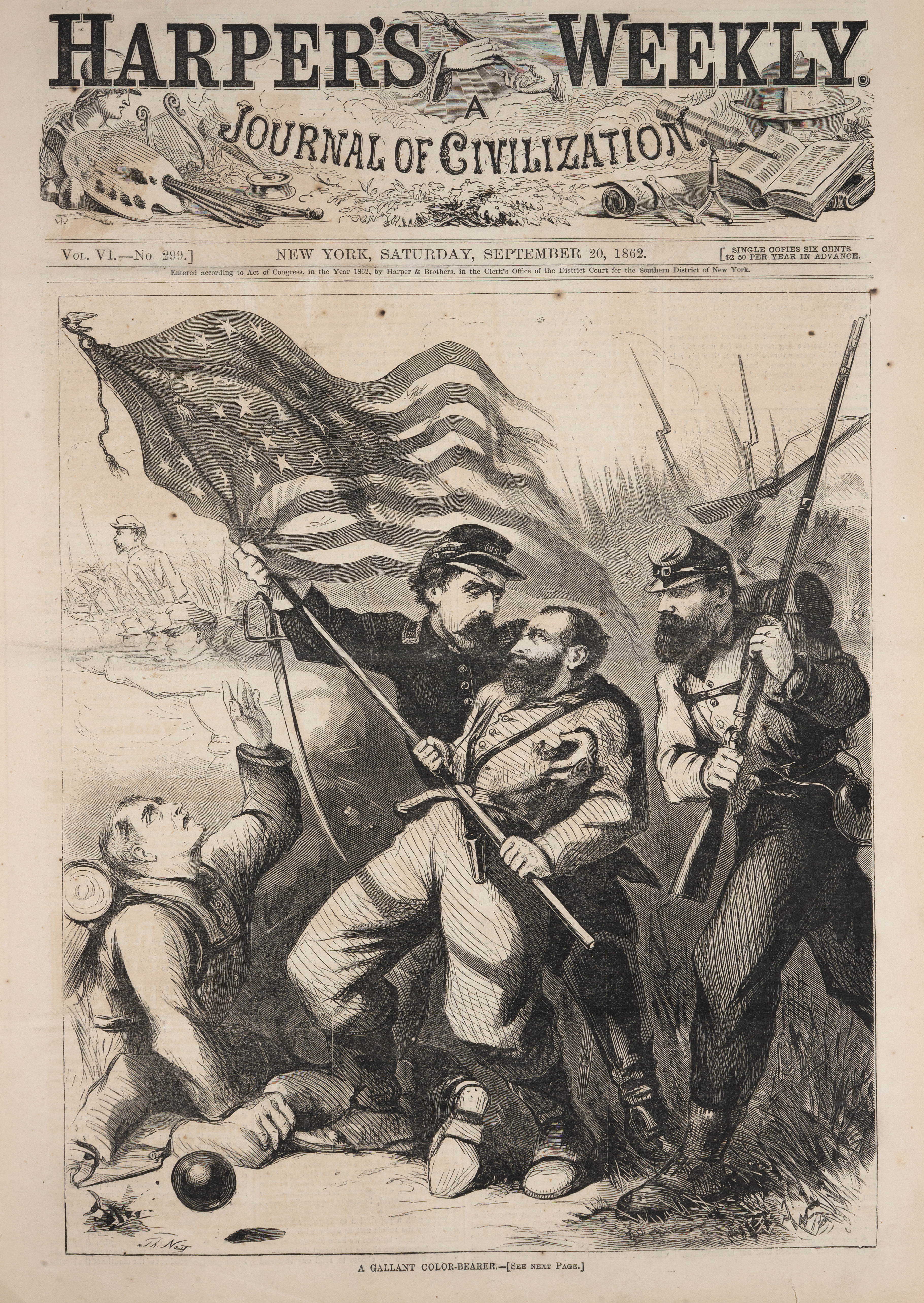
A Gallant Color-Bearer
Thomas Nast / Appeared in Harper’s Weekly / December 19, 1885
Thomas Nast was the first to “discover” that Santa Claus lived and worked in the North Pole. It made logistical sense for the workshop and home of Santa to be in the North Pole since it was a central location where Santa was relatively the same distance from all children in the Northern Hemisphere. The North Pole was also a remote location where Santa could not be spied on by curious children. Lastly, the North Pole was a cold and snowy setting which fit in with Santa and Mrs. Claus’s personae. In this drawing the children, Thomas Nast’s youngest son and daughter, Cyril and Mabel, plot Santa’s route from the North Pole to their house just across Macculloch Avenue.
Thomas Nast / Harper’s Weekly / December 25, 1886
Thomas Nast takes a literal spin to Clement Moore’s Christmas poem, A Visit from St. Nicholas and depicts sleeping mice on the mantle to describe the opening lines of the classic Christmas poem. Above the mantle is one of Nast’s images of Santa Claus and on the mantle next to the mice is a copy of a Christmas Sketches book.
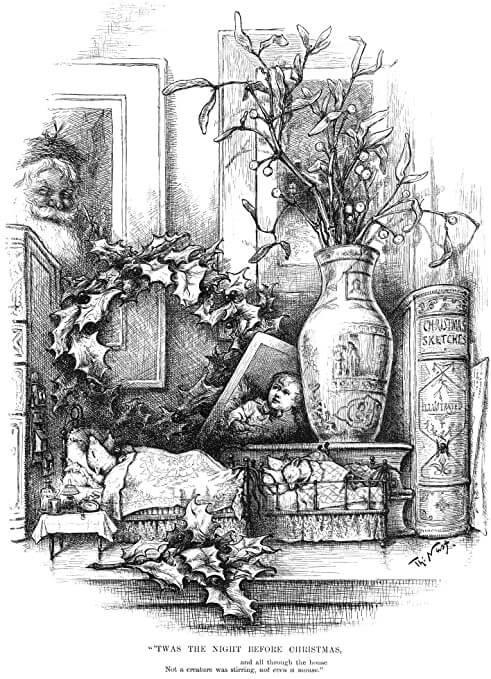
Thomas Nast / Engraving / Harper’s Weekly / December 30, 1876
Thomas Nast’s gentle humor comes through in this image in which a child tests Santa Claus’s generosity by hanging an extra-large stocking, labeled Mother, from the mantle. Nast often used his home,Villa Fontana, in Morristown, New Jersey as a setting for his Christmas images. Even in some of the engravings that do not feature Santa Claus as the main character, the artist often draws the jolly old elf in the background, as he does on the fire screen here.
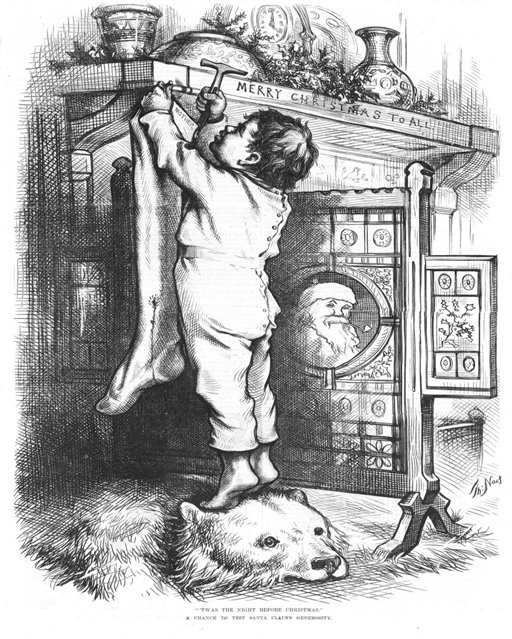
Thomas Nast / Artist’s Proof / Appeared in Harper’s Weekly / January 1, 1881
Of all the thousands of drawings Nast rendered, Merry Old Santa Claus was the single image he told his family he wanted to be remembered for. The artist succeeded, as this image is the icon of American Christmas.
Merry Old Santa Claus is actually a complex political image, rather than a sugary holiday image. Santa Claus holds an armful of toys, each carefully selected by Nast for their symbolism. The doll holds her arms outstretched in a begging gesture. The wooden pull horse invokes the legend of trickery of the Trojan horse. Between the horse and doll is a model tin kitchen, a popular Victorian toy, representing hearth and home. The sand pail, growing in popularity in the 1880s as Americans discovered seashore vacations, represents the adage of an ostrich burying its head in the sand. Nast is portraying more than the festive gifts of the holiday season.
Three additional objects carried by Santa Claus in this image reveal the true meaning of the illustration. The pocket watch hanging from Santa’s finger indicates a few minutes before midnight. Rather than signifying the approaching moment when Santa Claus will travel across the night sky delivering gifts, the watch shows that at midnight on New Year’s Eve all Congressional legislation not passed will expire without action. Over Santa’s arm hangs an officer’s dress sword and on his back, rather than a sack of toys, is an enlisted soldier’s knapsack. These three elements are the key and tie the image together.
At the time Nast created Merry Old Santa Claus, Congress was debating a pay increase for the United States military. He was staunchly pro-military and believed that for their risk and heroism, soldiers and sailors were due just wages. Nast’s subtext in this holiday icon is “If Santa can bring gifts to our soldiers and sailors, why can’t Congress provide a decent living wage?”
